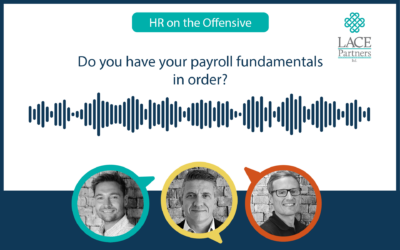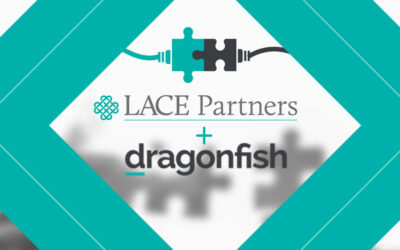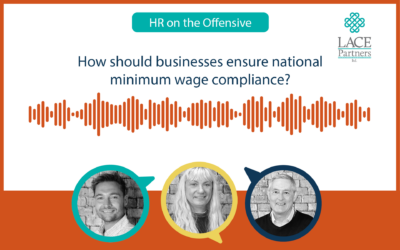As the big tech firms scramble to try to deliver the next evolution of how AI will impact businesses following the rapid rise to prominence of ChatGPT from Tech firm OpenAI, HR professionals that we speak to are starting to ask us how the application of it could help to support their function and, critically why should they care so much about it? After all, there are some functions, skills and behavioural parts of the HR/People Function that should only ever be delivered by a person – shouldn’t it?
Today’s blog is from Aaron Alburey in our team as he explores the impact of this latest generation of AI-powered technology that exists and how it could potentially change the role of HR professionals forever…
The common use of AI: recruitment
AI has the potential to fundamentally change the way in which your HR function operates. We run a host of different events, podcasts and have written a number of pieces over the years about AI, but up until the rapid rise in awareness of ChatGPT, the answer we have consistently come across from HR professionals has been relatively consistent:
“We have experimented with AI, but mainly through areas such as in recruitment, where we are dealing with large volumes of applications”
Of course, recruitment and talent acquisition has been a function whereby the need has been easy to understand why organisations have adopted it to a degree of success. In today’s competitive job market, it’s essential to have the best talent on your team and AI-powered recruitment tools can help the Talent Acquisition Teams quickly identify the most suitable candidates for the job, ensuring that you hire the best talent. Elements of AI and machine learning have existed in recruitment for a while, and avoiding bias has long been considered one of the significant problems. One of the issues here is that AI is only going to find similarities to what already exists in an organisation, so bias can still be a problem based on previous hiring.
There are pitfalls to be aware of where an organisation might indirectly discriminate against people whose data sets are not updated much, especially when identifying top talent within a large organisation. Being conscious of the ethics behind AI and machine learning is essential. Ultimately, the legal buck stops with the employer.
How can AI help employee engagement and retention?
Keeping your employees engaged and motivated is crucial for business success. AI-powered surveys can provide valuable insights into employee sentiment, allowing HR professionals to make data-driven decisions to improve employee engagement and retention, ultimately boosting business productivity and profitability. And the technology is already out there for you to utilise. Businesses like Qualee, Leena and Impulse are just three that you can use to evaluate employee sentiment, for example.
But whilst these platforms can help with rapid data generation and provide you with information around employees, or the business, can it truly deliver the insights and decision making that you as a business need? How do you make it usable? Can you truly just rely on your decision making based purely on AI, or should there be a complimented mix of the two i.e. data generated from AI coupled with the experience and knowledge of HR practitioners.
Does AI bring about the opportunity for HR to truly develop into ‘people consultants’?
In 2019 we released our whitepaper HR on the Offensive, in which we talked about HR stepping out of the shadows, demonstrating that as a business unit we could think more strategically and act less as an operational and transactional function. In 2021 we produced our Future of HR Shared Services: Becoming people experience and solutions experts and we talked about how HR teams need to act more like consultants to the business, continuing the themes of our first whitepaper.
If the application of AI can be used to reduce administrative time spent on tasks, perhaps the introduction of effective AI can allow HR professionals to focus on becoming more consultative to their business, provide insight and recommendations on important strategic people decisions, like future of skills needed within the workforce, or focusing on effective strategic workforce planning (SWP). Take areas such as performance management; Effective performance management is key to driving employee productivity and achieving business goals. With AI-powered tools, HR professionals can track and analyse employee performance data, identify patterns and trends, and make informed decisions about training and development, helping to unlock the full potential of your workforce.
Again, the tools already exist here, with organisations including BetterWorks, Reflektive and 15Five that all deliver an AI-powered performance management approach.
But again, caution must be heeded, because we are dealing with humans here and applying a blanket approach of entrusting AI to the whole process when you are dealing with human emotions is always going to be a challenge.
Learning and development (L&D)
In the world of L&D, where more and more organisations are looking to tailor the experience of their employees based on individual preferences, it seems obvious to state that AI has a massive role to play. AI can help personalise learning and development opportunities for employees by analysing their performance data and recommending relevant training programs and resources, helping your workforce to stay ahead of the curve. We’ve already mentioned in previous blogs software such as EdCast, Degreed and HowNow platforms. Many other tools exist but as we’ve stated throughout today’s blog, these tools can improve user experience, if used correctly they add massive value, but there still needs to be a human that is driving the application and adoption of them.
Embrace – because it won’t replace
AI and AI-powered tools are rapidly evolving and HR needs to look to embrace the benefits of it. Making sure decisions aren’t made on spurious data, for instance – but not using AI will leave organisations lagging, as undoubtedly, their competitors will be implementing AI to get to their end goal more quickly and efficiently.
At LACE, we recently did an experiment where we asked ChatGPT to describe our business. Interestingly, 80% of it was correct, whilst the other 20% described a business that none of us recognised. However, it certainly drew the information from somewhere. In fact we even used ChatGPT on the theme for today’s blog, but after the initial impressive response, realised that there was a need for human intervention to provide more than a standard and simplified piece of content. There was little ‘so what?’ about the response and so couple with human intervention, we’ve created today’s blog. So, the continuous testing and quality-checking of what AI generates are critical to ensure the content is correct. Human intervention is always going to be needed. But the possibilities to automate tasks and improve productivity is definitely there.
There are also ethical questions that are still yet to be truly ironed out. Generative AI like ChatGPT can be used to automate manual tasks in some instances, but does that mean that it should? What about potential plagiarism and employees releasing work as their own when it is not? Do you have a policy in place that could cover any potential legal issues around this if it were to occur? These are all the types of questions that businesses are wrestling with and the answers will take a while longer to assess yet.
If you’d like to talk to us about how AI and other tools can improve the productivity of your workforce, we’d be happy to chat. Simply fill in the form below and we’ll get in touch.






